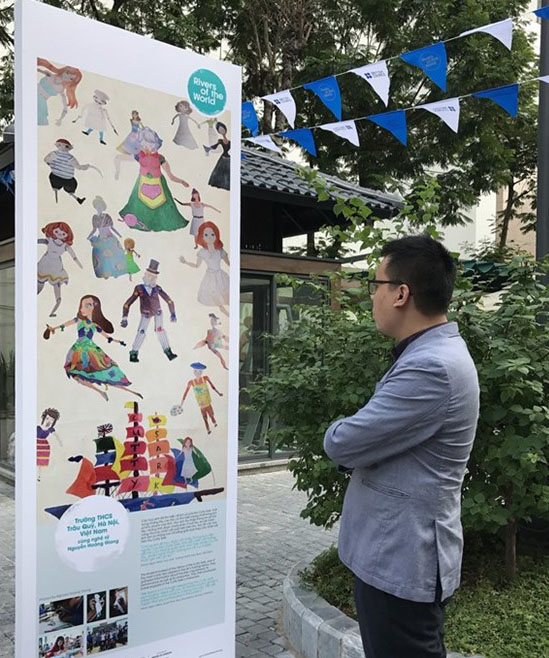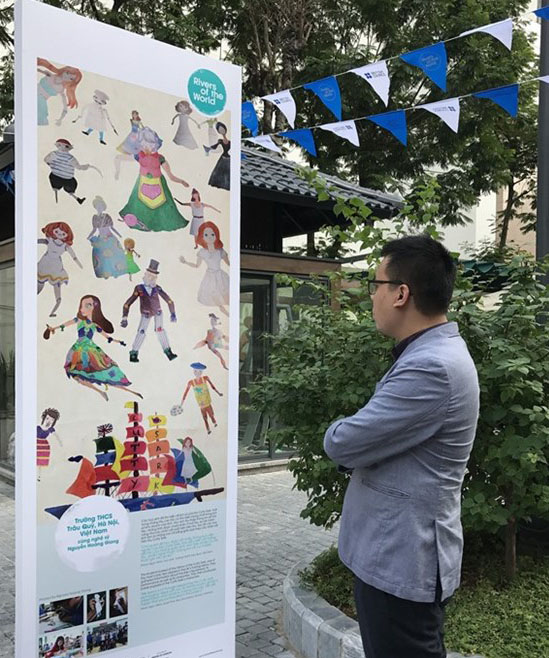



An exhibition visitor looks at a work
of art by Trau Quy Secondary School’s students on Hanoi’s Book Street (Photo
courtesy of British Council)
The Rivers of the World project is an 11 year-old UK initiative that has asked
schools in 28 countries to spend a year researching and creating art about
local rivers. The following year, the schools are partnered with peers in the
UK to research British rivers. In 2017, 69 artworks have been produced by 69
schools from Ethiopia; Zambia; Nigeria; Sierra Leone; Nepal; Vietnam and the
UK.
The artwork on display was previously shown at the project’s global exhibition,
which was held in London as one of the marquee events at the Thames Festival
from September 1 to 30.
In Vietnam, the British Council has worked with the Ministry of Education and
Training to implement the project for two years, bringing local artists to
encourage pupils as they learn about local rivers in the first year and their
partner’s river in the second.
With instruction from artist Nguyen Hoang Giang, pupils from Gia Thuy; Dong
Thai; Luong The Vinh; Phuong Mai; Nguyen Du and Trau Quy created pieces
reflecting current environmental concerns, while drawing on historical events
such as The Great Stink of 1858, when the Thames River was severely polluted by
sewage.
At Trau Quy Secondary School, the pupils looked at the history of Cutty Sark,
one of the most iconic tea clippers in the UK’s trading history. They gathered
information about the ship’s figurehead, characteristics and important people
in its history. They then produced paper puppets depicting the individuals.
"We learn a lot through researching the Cutty Sark, exchanging ideas with
our UK partner school, giving a presentation and certainly making artwork. We
are happy that we participated in the project," said pupil Pham Ngoc Minh.
The UK’s tea culture was chosen by the pupils from Phuong Mai Secondary School
to be this year’s theme, as tea is enjoyed in both Vietnamese and British
cultures. The pupils looked at the history of tea in the UK and cultural
practices around this special beverage. They also compared their findings with
tea culture in Vietnam. They assembled paper teapots and decorated them with
images of London for their final artwork.
"The River of the World project gave me an opportunity to learn about the
UK’s rivers but also their tea culture. I learned that the way they drink tea
is a bit different from ours," said pupil Phan Minh Nghia.
Following a recommendation from their partner school, Gia Thuy School’s pupils
researched the Great Stink of 1858 and its consequences. They watched a short
documentary about how improved hygiene conditions resolved the river’s garbage
problem. The pupils learned water transfer printing and created their own representations
of the polluted Thames using discarded plastic bottles and cups.
"This is the second year that our students participated in the project,” said
teacher Nguyen Thi Hien. "Throughout the process, our students have learnt a
great deal about team work, research and art. But most importantly, the project
raised their awareness of the need to protect our environment.”
At Luong The Vinh Secondary School, the pupils were inspired by the Thames
Barrier, a structure that prevents London from experiencing annual floods. They
watched documentaries and produced stencil prints showing London safe from
floods due to the Thames Barrier.
The students at Dong Thai Secondary School researched the Thames salmon
initiative. They learnt that the Thames was heavily polluted by
industrial activities, making it impossible for many fish species, especially
salmon, to survive. In recent years, however thanks to some initiatives by the
UK government, the water quality has improved significantly and fish have
returned to their natural habitats. Taking inspiration from this, the pupils
made collages depicting an optimistic future for the health of the Thames.
The exhibition will run until November 30.
Source: VNA